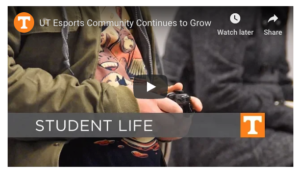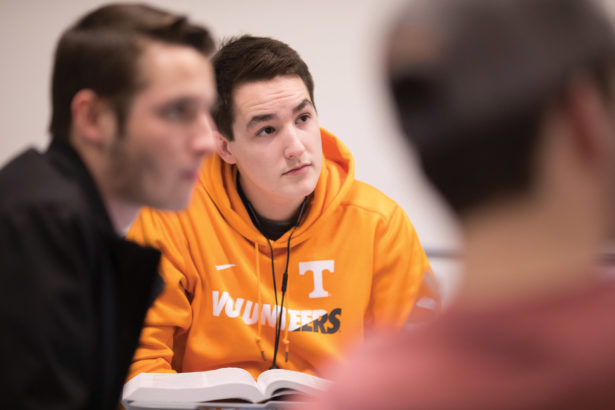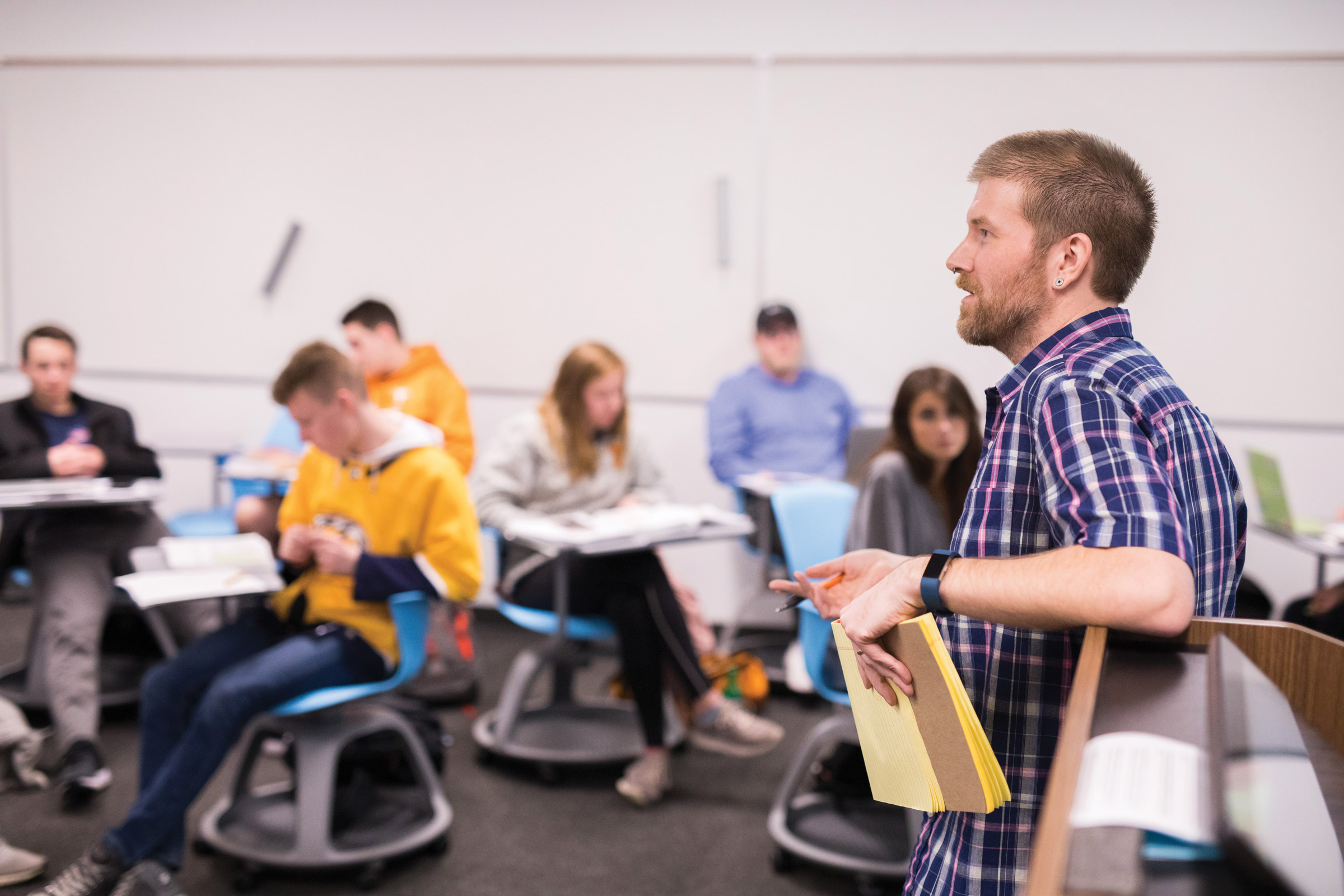By Amy Blakely | Photos by Steven Bridges
A couple of years ago, Ryan Windeknecht, a lecturer in UT Knoxville’s Department of Philosophy, was looking for a way to get students more interested in his 200-level general education philosophy course, Professional Responsibility.
“For the overwhelming majority of my students, it is the first and last philosophy class they will ever take,” he says.
He struggled with how to make it relevant for students from a variety of majors and a wide range of career aspirations.
“I play Dungeons and Dragons with several colleagues from the philosophy department,” he says. “And one day it hit me—Dungeons and Dragons could solve my problems.”

Increasingly, faculty are using gaming—from board games and role playing to simulation and video games—to capture student attention, teach difficult material and promote creative thinking.
A story in Forbes magazine explains, “(Gen Z students) aren’t interested in simply showing up for class, sitting through a lecture and taking notes that they’ll memorize for an exam later on. Instead, they expect to be fully engaged and to be a part of the learning process themselves.”
The category of simulations, gaming and role playing (SGR) is now recognized as one of the 12 forms of experiential learning at UT Knoxville. Ten of the university’s 11 colleges have offered courses with an SGR component in the past three years. UT recently began offering instructors the chance to earn a teaching certificate in gaming and role playing. About 40 have done so.

A group of faculty members interested in this teaching technique have formed the Gaming Community of Scholars to share ideas and collaborate. Windeknecht leads the group.
Windeknecht redesigned Professional Responsibility using Dungeons and Dragons as a model: Students are assigned professions corresponding to their game characters. Using philosophical theories, they must embody and work out ethical problems to progress through the semester-long game.

The game approach worked so well, Windeknecht incorporated it into other classes he teaches.
In a 100-level introduction to philosophy course, he uses a low-fantasy deck-building card game to help students learn how to make arguments. And, in a first-year honors seminar, he uses a postapocalyptic storytelling and mapmaking game to help students explore their sense of self.
Recreating the Past
Outside of the classroom, history lecturer Marina Maccari-Clayton is not a gamer. “My son makes fun of me because he showed me how to play Plants vs. Zombies a few years ago, and it is still the only game I play on a regular basis.”
But, in the classroom, she’s a firm believer.
For several years, she’s used Reacting to the Past, a gaming strategy developed by a history professor at Barnard College in the late 1990s.
“Reacting is a live-action role-playing course where students recreate and redecide important events in history,” Maccabi-Clayton says. “It is now used at hundreds of colleges and universities across the United States.”
‹ Don’t be mistaken, this is not Candyland – or even Clue. ›
“Since the fall of 2016, students in my courses have debated the merits and flaws of Athenian democracy in the aftermath of the Peloponnesian War; the tensions between the prerogative of the state and the rights of the individual in the late Roman republic; the struggle between secular and temporal power during the Second Crusade; the importance of the ‘rights of man’ in revolutionary France; the impact of machine labor and the factory system in 1818 Manchester, England; the clash of miasmatic and germ theories during the 1854 cholera pandemic in London; and the meaning of national interest in the context of the July Crisis of 1914.”

Each game takes two to three weeks to set up.
“I introduce the historical context, guide the students through the analysis of core texts, and provide them with individual role sheets and victory objectives. Once the game starts, student players apply what they have learned during the setup phase and devise strategies to attain victory through formal speeches, informal debates, negotiations and sometimes conspiracy.”
‹ Students like the game approach to learning history. ›
“Reacting to the Past does wonders to show that the people within the textbook aren’t simply characters but real human beings who fought their way through those ordeals,” one student wrote in a class evaluation.
Another agrees: “I enjoyed living out the hardships of a life different from mine and facing decisions I would otherwise never make. Having to deal with varying historical situations through my assigned character made it easier to remember details.”
Maccari-Clayton trains other faulty to use Reacting to the Past in their classes. She understands if they’re skeptical; she was, too, at first.
“I wondered whether the growing field of gamification in an educational setting was just a fad,” she says. “I could not ignore, however, a growing body of literature speaking to its effectiveness in producing deeper engagement with the material among the students and improving retention in general education courses.”
Parlez-vouz français?
Several years ago, Cary Staples, a professor in graphic design, was trying to encourage her freshman students to experiment. They wanted the right answer. She wanted them to generate multiple options and choose the best answer.
Staples got an idea from watching her son play a video game. He was exploring, trying one approach, failing and trying something new.

“Design is just like that,” she says. Experiment, try multiple options, then choose the best one.
She sought out conferences to learn more about the art of game design, and she began designing gaming experiences for some of her classes.
A colleague who taught French learned about her work and suggested they collaborate on a project combining their two areas of expertise.
They devised a course in which students would build a video game to teach basic French. Students in the course could earn credit in one of two areas: cultures and civilization or art.
The result was an app called Bonne Chance. While the first iteration focused on grammar and was basically “expensive flashcards,” in Staples’s words, subsequent classes have continued to work on the game each semester, and it’s become more sophisticated over time.
Working on Bonne Chance requires class members to use their individual skills as artists, musicians, actors and computer designers, Staples says.
‹ “Together, they create something none of them could create by themselves.” ›
Graphic design sophomore Taylor Bogle is taking the class because she’s a board game fanatic and works for Bézier Games, a local company that creates board and card games. Besides expanding her thoughts about game design, Bonne Chance has sparked Bogle’s interest in learning French and exploring French culture.
Jared Robson, a junior in graphic design, is taking the class because he wants to be a game designer. A U.S. Marine veteran, he said video games helped him readjust to civilian life.
“Video games helped me ground myself and change my mindset from, ‘The loud noises are going to hurt me’ to, ‘It’s just another noise.’”
He’d like to help other returning veterans by creating “a more realistic game, possibly a virtual reality game, that could fully immerse someone and help to rewrite the negative reactions and muscle memory developed during a time of war.”



